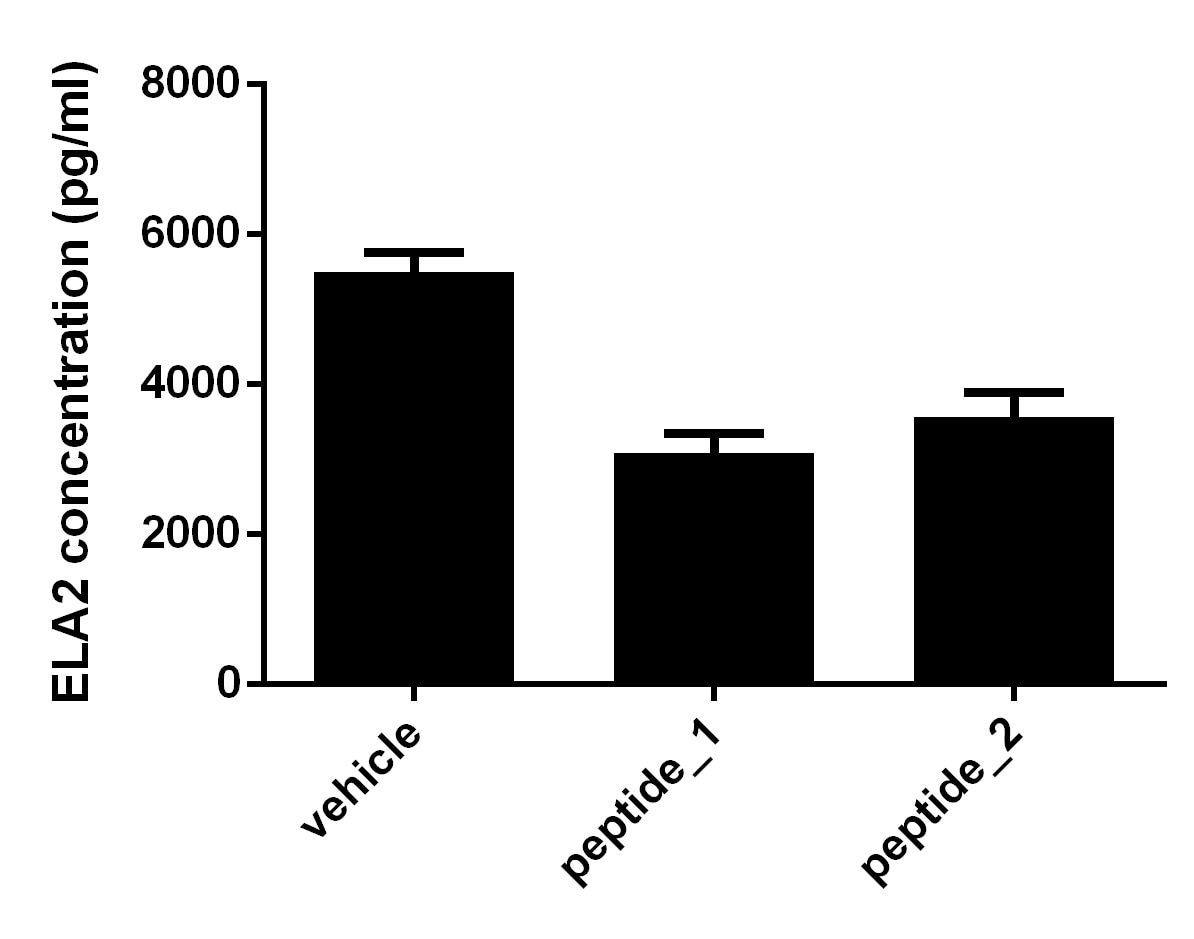Mouse Neutrophil Elastase/ELA2 Quantikine ELISA Kit Summary
Product Summary
Precision
Cell Culture Supernates, Tissue Lysates, Serum, EDTA Plasma, Heparin Plasma
| Intra-Assay Precision | Inter-Assay Precision | |||||
|---|---|---|---|---|---|---|
| Sample | 1 | 2 | 3 | 1 | 2 | 3 |
| n | 20 | 20 | 20 | 20 | 20 | 20 |
| Mean (pg/mL) | 104 | 254 | 735 | 96.9 | 238 | 709 |
| Standard Deviation | 1.28 | 3.64 | 15.7 | 9.39 | 17.4 | 43.6 |
| CV% | 1.2 | 1.4 | 2.1 | 9.7 | 7.3 | 6.1 |
Recovery
The recovery of mouse ELA2 spiked to three levels throughout the range of the assay in various matrices was evaluated.
| Sample Type | Average % Recovery | Range % |
|---|---|---|
| Cell Culture Media (n=4) | 96 | 90-102 |
| Cell Lysis Buffer (n=3) | 96 | 91-97 |
| EDTA Plasma (n=4) | 108 | 95-125 |
| Heparin Plasma (n=4) | 108 | 101-118 |
| Serum (n=4) | 112 | 104-122 |
Linearity
Scientific Data
Product Datasheets
Preparation and Storage
Background: Neutrophil Elastase/ELA2
Neutrophil Elastase (ELA2), also known as polymorphonuclear leukocyte elastase, is a serine protease belonging to the chymotrypsin family. Located primarily in the azurophil granules of polymorphonuclear leukocytes, ELA2 function results in the degradation of many extracellular matrix macromolecules. Alpha-1 Antitrypsin (Serpin A1) and secretory leukocyte protease inhibitor (SLPI) have been shown to inhibit ELA2 activity. ELA2 may be involved in lung emphysema, cystic fibrosis, the adult respiratory distress syndrome (ARDS), rheumatoid arthritis, tumor invasion and infectious diseases.
Citations for Mouse Neutrophil Elastase/ELA2 Quantikine ELISA Kit
R&D Systems personnel manually curate a database that contains references using R&D Systems products. The data collected includes not only links to publications in PubMed, but also provides information about sample types, species, and experimental conditions.
4
Citations: Showing 1 - 4
Filter your results:
Filter by:
-
Combined Insults of a MASH Diet and Alcohol Binges Activate Intercellular Communication and Neutrophil Recruitment via the NLRP3-IL-1? Axis in the Liver
Authors: Babuta, M;Nagesh, PT;Datta, AA;Remotti, V;Zhuang, Y;Mehta, J;Lami, F;Wang, Y;Szabo, G;
Cells
Species: Mouse
Sample Types: Cell Lysates, Serum
-
Targeting cathepsin C ameliorates murine acetaminophen-induced liver injury
Authors: Raith, J;Bachmann, M;Gonther, S;Stülb, H;Aghdassi, AA;Pham, CTN;Mühl, H;
Theranostics
Species: Transgenic Mouse, Mouse
Sample Types: Serum
-
CD14 Blockade Does Not Improve Outcomes of Deep Vein Thrombosis Following Inferior Vena Cava Stenosis in Mice
Authors: Pandey, N;Kaur, H;Chandaluri, L;Anand, SK;Chokhawala, H;Magdy, T;Stokes, KY;Orr, AW;Rom, O;Dhanesha, N;
bioRxiv : the preprint server for biology
Species: Mouse
Sample Types: Plasma
-
Pseudomonas aeruginosa-induced nociceptor activation increases susceptibility to infection
Authors: T Lin, D Quellier, J Lamb, T Voisin, P Baral, F Bock, A Schönberg, R Mirchev, G Pier, I Chiu, M Gadjeva
PloS Pathogens, 2021-05-06;17(5):e1009557.
Species: Mouse
Sample Types: Tissue Homogenates
FAQs
No product specific FAQs exist for this product, however you may
View all ELISA FAQsReviews for Mouse Neutrophil Elastase/ELA2 Quantikine ELISA Kit
Average Rating: 5 (Based on 1 Review)
Have you used Mouse Neutrophil Elastase/ELA2 Quantikine ELISA Kit?
Submit a review and receive an Amazon gift card.
$25/€18/£15/$25CAN/¥75 Yuan/¥2500 Yen for a review with an image
$10/€7/£6/$10 CAD/¥70 Yuan/¥1110 Yen for a review without an image
Filter by:





